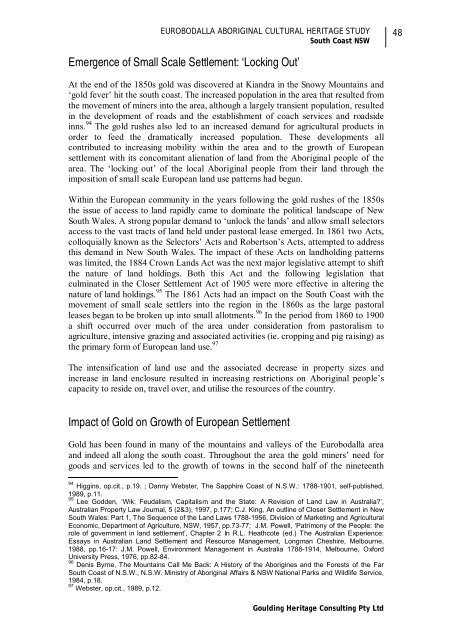Pages 9 - 77 (1600kb) - Eurobodalla Shire Council
Pages 9 - 77 (1600kb) - Eurobodalla Shire Council
Pages 9 - 77 (1600kb) - Eurobodalla Shire Council
Create successful ePaper yourself
Turn your PDF publications into a flip-book with our unique Google optimized e-Paper software.
EUROBODALLA ABORIGINAL CULTURAL HERITAGE STUDY<br />
South Coast NSW<br />
Emergence of Small Scale Settlement: ‘Locking Out’<br />
At the end of the 1850s gold was discovered at Kiandra in the Snowy Mountains and<br />
‘gold fever’ hit the south coast. The increased population in the area that resulted from<br />
the movement of miners into the area, although a largely transient population, resulted<br />
in the development of roads and the establishment of coach services and roadside<br />
inns. 94 The gold rushes also led to an increased demand for agricultural products in<br />
order to feed the dramatically increased population. These developments all<br />
contributed to increasing mobility within the area and to the growth of European<br />
settlement with its concomitant alienation of land from the Aboriginal people of the<br />
area. The ‘locking out’ of the local Aboriginal people from their land through the<br />
imposition of small scale European land use patterns had begun.<br />
Within the European community in the years following the gold rushes of the 1850s<br />
the issue of access to land rapidly came to dominate the political landscape of New<br />
South Wales. A strong popular demand to ‘unlock the lands’ and allow small selectors<br />
access to the vast tracts of land held under pastoral lease emerged. In 1861 two Acts,<br />
colloquially known as the Selectors’ Acts and Robertson’s Acts, attempted to address<br />
this demand in New South Wales. The impact of these Acts on landholding patterns<br />
was limited, the 1884 Crown Lands Act was the next major legislative attempt to shift<br />
the nature of land holdings. Both this Act and the following legislation that<br />
culminated in the Closer Settlement Act of 1905 were more effective in altering the<br />
nature of land holdings. 95 The 1861 Acts had an impact on the South Coast with the<br />
movement of small scale settlers into the region in the 1860s as the large pastoral<br />
leases began to be broken up into small allotments. 96 In the period from 1860 to 1900<br />
a shift occurred over much of the area under consideration from pastoralism to<br />
agriculture, intensive grazing and associated activities (ie. cropping and pig raising) as<br />
the primary form of European land use. 97<br />
The intensification of land use and the associated decrease in property sizes and<br />
increase in land enclosure resulted in increasing restrictions on Aboriginal people’s<br />
capacity to reside on, travel over, and utilise the resources of the country.<br />
Impact of Gold on Growth of European Settlement<br />
Gold has been found in many of the mountains and valleys of the <strong>Eurobodalla</strong> area<br />
and indeed all along the south coast. Throughout the area the gold miners’ need for<br />
goods and services led to the growth of towns in the second half of the nineteenth<br />
94<br />
Higgins, op.cit., p.19. ; Danny Webster, The Sapphire Coast of N.S.W.: 1788-1901, self-published,<br />
1989, p.11.<br />
95<br />
Lee Godden, ‘Wik: Feudalism, Capitalism and the State: A Revision of Land Law in Australia?’,<br />
Australian Property Law Journal, 5 (2&3), 1997, p.1<strong>77</strong>; C.J. King, An outline of Closer Settlement in New<br />
South Wales: Part 1, The Sequence of the Land Laws 1788-1956, Division of Marketing and Agricultural<br />
Economic, Department of Agriculture, NSW, 1957, pp.73-<strong>77</strong>; J.M. Powell, ‘Patrimony of the People: the<br />
role of government in land settlement’, Chapter 2 In R.L. Heathcote (ed.) The Australian Experience:<br />
Essays in Australian Land Settlement and Resource Management, Longman Cheshire, Melbourne,<br />
1988, pp.16-17: J.M. Powell, Environment Management in Australia 1788-1914, Melbourne, Oxford<br />
University Press, 1976, pp.82-84.<br />
96<br />
Denis Byrne, The Mountains Call Me Back: A History of the Aborigines and the Forests of the Far<br />
South Coast of N.S.W., N.S.W. Ministry of Aboriginal Affairs & NSW National Parks and Wildlife Service,<br />
1984, p.18.<br />
97<br />
Webster, op.cit., 1989, p.12.<br />
Goulding Heritage Consulting Pty Ltd<br />
48
















